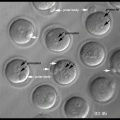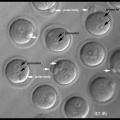File:Mouse blastocyst movie pronuclei.jpg: Difference between revisions
(==Mouse Blastocyst Development== This shows embryo development observed using time-lapse microscopy from the pronuclear to blastocyst stages without using a specialized incubation chamber. ===Offspring from mouse embryos developed using a simple incubat) |
mNo edit summary |
||
| (2 intermediate revisions by the same user not shown) | |||
| Line 2: | Line 2: | ||
This shows embryo development observed using time-lapse microscopy from the pronuclear to blastocyst stages without using a specialized incubation chamber. | This shows embryo development observed using time-lapse microscopy from the pronuclear to blastocyst stages without using a specialized incubation chamber. | ||
{{Mouse blastocyst movie}} | {{Mouse blastocyst movie}} | ||
===Reference=== | ===Reference=== | ||
<pubmed>23056643</pubmed>| [http://www.plosone.org/article/info%3Adoi%2F10.1371%2Fjournal.pone.0047512 | <pubmed>23056643</pubmed>| [http://www.plosone.org/article/info%3Adoi%2F10.1371%2Fjournal.pone.0047512 PLoS ONE] | ||
====Copyright==== | |||
© 2012 Itoi et al. This is an open-access article distributed under the terms of the Creative Commons Attribution License, which permits unrestricted use, distribution, and reproduction in any medium, provided the original author and source are credited. | |||
Citation: Itoi F, Tokoro M, Terashita Y, Yamagata K, Fukunaga N, et al. (2012) Offspring from Mouse Embryos Developed Using a Simple Incubator-Free Culture System with a Deoxidizing Agent. PLoS ONE 7(10): e47512. doi:10.1371/journal.pone.0047512 | Citation: Itoi F, Tokoro M, Terashita Y, Yamagata K, Fukunaga N, et al. (2012) Offspring from Mouse Embryos Developed Using a Simple Incubator-Free Culture System with a Deoxidizing Agent. PLoS ONE 7(10): e47512. doi:10.1371/journal.pone.0047512 | ||
{{Footer}} | |||
[[Category:Mouse]] [[Category:Zygote]] [[Category:Morula]] [[Category:Blastocyst]] | [[Category:Mouse]] [[Category:Zygote]] [[Category:Morula]] [[Category:Blastocyst]] | ||
Latest revision as of 07:33, 10 November 2015
Mouse Blastocyst Development
This shows embryo development observed using time-lapse microscopy from the pronuclear to blastocyst stages without using a specialized incubation chamber.
- Blastocyst Links: MP4 version | Quicktime version | Mouse Development | Blastocyst Development | Movies
Reference
<pubmed>23056643</pubmed>| PLoS ONE
Copyright
© 2012 Itoi et al. This is an open-access article distributed under the terms of the Creative Commons Attribution License, which permits unrestricted use, distribution, and reproduction in any medium, provided the original author and source are credited.
Citation: Itoi F, Tokoro M, Terashita Y, Yamagata K, Fukunaga N, et al. (2012) Offspring from Mouse Embryos Developed Using a Simple Incubator-Free Culture System with a Deoxidizing Agent. PLoS ONE 7(10): e47512. doi:10.1371/journal.pone.0047512
Cite this page: Hill, M.A. (2024, April 18) Embryology Mouse blastocyst movie pronuclei.jpg. Retrieved from https://embryology.med.unsw.edu.au/embryology/index.php/File:Mouse_blastocyst_movie_pronuclei.jpg
- © Dr Mark Hill 2024, UNSW Embryology ISBN: 978 0 7334 2609 4 - UNSW CRICOS Provider Code No. 00098G
File history
Click on a date/time to view the file as it appeared at that time.
| Date/Time | Thumbnail | Dimensions | User | Comment | |
|---|---|---|---|---|---|
| current | 18:02, 14 October 2012 |  | 480 × 480 (32 KB) | Z8600021 (talk | contribs) | |
| 18:00, 14 October 2012 |  | 480 × 480 (32 KB) | Z8600021 (talk | contribs) | ||
| 17:54, 14 October 2012 |  | 480 × 480 (30 KB) | Z8600021 (talk | contribs) | ==Mouse Blastocyst Development== This shows embryo development observed using time-lapse microscopy from the pronuclear to blastocyst stages without using a specialized incubation chamber. ===Offspring from mouse embryos developed using a simple incubat |
You cannot overwrite this file.
File usage
The following 2 pages use this file: